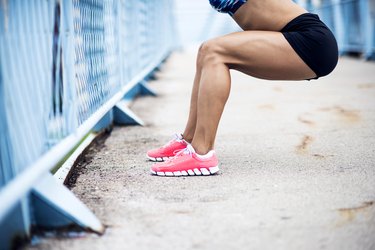
Tense thighs can make simple tasks like getting up from a chair quite difficult. Front thigh muscle tightness can be caused by such issues as poor posture, stiff hip joints, a stiff spine or too much neural stimulation in the thigh and hip flexors. Different causes of muscle tightness require different approaches to lengthen and relax the area; there are no cookie-cutter workouts that fit every situation.
Tip
Tightness of the front thigh muscles can develop from inactivity and poor posture.
Video of the Day
Tight Thigh Muscles
When muscle fibers contract, the microscopic contractile proteins — actin and myosin — cross each other and shorten the muscle. When there is too much neural stimulation to the muscle — either because you're overworking it or because you have a nutrient imbalance — the muscle stays contracted. This muscle cramp can lead to joint stiffness that prevents your hip joint from extending when you run, walk or climb stairs.
Video of the Day
Without proper hip extension, your stride will not allow you to move faster without risking back pain or knee pain. Poor hip extension also causes your lower back to hyperextend to compensate for the lack of movement in the joint from tight hip flexors.
Read more: How to Improve Tight and Weak Quadriceps
Poor Standing Posture
An elevation postural deviation is diagnosed when one side of your body is higher than the other, such as a shoulder or one side of your pelvis. If one side of your pelvis is higher than the other side, then the shoulder on the same side of the raised hip will hike up. This causes the muscles and tissues in the lowered hip and shoulder to compress downward, causing tight hip flexors and a tight leg on one side.
Stiff Hip Joints
Hip stiffness may render you unable to move your hip joints in all ranges of motion, including rotation, flexion and extension. This is often caused by sitting too much and not moving enough.
For example, when your hip flexors get tight from sitting and your buttocks and deep abdominal stabilizers get weak from lack of use, this tightens your hip flexors, which pulls on the lumbar spine and the upper thigh and causes your front thighs to get tight.
Prevention of Tense Thighs
Stretching your tight hip flexors and strengthening your hip and spine will help prevent your thigh muscles from getting tight and stiff. This reduces the amount of neural stimulation to your muscles and connective tissues, allowing your hip to open up more. As a rule of thumb, moving regularly with less sitting will decrease front thigh tightness.
HOW TO DO IT: Kneel on the leg with tight hip flexors. Keep the other knee bent in front of you with your heel on the ground. Keeping your back straight and chest up, slowly lean forward until you feel a strong pull at the front of your tight hip. Hold for 30 seconds and repeat three times.
If you have an elevation deviation, you can perform corrective exercises that balance your body and improve your pelvic, spinal and shoulder alignment. The types of exercises you should do will depend on the severity of your deviation, your physical condition and your pain level. See a physical therapist for an individualized exercise program.
Read more: Stretches for Tight Quads
Is this an emergency? If you are experiencing serious medical symptoms, please see the National Library of Medicine’s list of signs you need emergency medical attention or call 911.